Having enough space for a garden is common in a small town in the south, but it’s very rare in the bigger cities. Farms, gardens and other local produce producers are such a huge asset and it would be a shame for people to miss out because of where they live. Gardening is one of the best ways to make sure you’re getting a good quality product and it would be a shame for people to miss out because of where they live.
While it isn’t impossible to garden in a small space, there are limitation and things you should consider before starting a garden. Choose wisely. When you don’t have a lot of space don’t grow plants that take up lots of space, have a long growing season or you don’t love to eat! Grow vegetables that are hard to find and not usually on the supermarket shelves, and select varieties for superior taste rather than crop size.
Choose plants suited to your small space. Some plants need more shade, some need more sun. ‘Dwarf’ varieties are ideal for small spaces because they produce a lot in a little space. Herbs are among the easiest categories of food plants to grow. And because fresh herbs can be rather expensive, these easy growers are cost-effective in a small-space garden. For individual advice, watch your gardening area for a full day and calculate how many hours of direct sunlight it gets, then read seed catalogs or visit a local garden center and ask for advice for your climate.
Grow fewer vegetables of each type. In a large garden 20 celery plants can be grown, in a small space garden you may want to grow only half a dozen, and in a balcony garden two or three plants will provide fresh stalks for cutting. In courtyards and against a warm wall you can often get planting long before the soil in a traditional garden has warmed enough for planting out and seed sowing.
Succession planting. Plant a few at a time, this avoids surpluses of produce and ensures that three is always something ready to eat in the garden. Growing a few seeds in a propagator or on a windowsill means that you can jump-start the season. Avoid planting all the seeds at once so they won’t be ready all at once. Fold over the top of the seed packet and store in a cool, dry, dark place, the back of a kitchen cabinet is just fine. The seedling plants can then be introduced into the garden when they are a few inches high to grow to maturity.
Growing in containers is a great option. Even if you don’t have any soil you can still grow a few choice vegetables. There are many striking plants that make attractive and productive container plants.
Make sure the container is big enough for the plants root development.
Remember that plants in containers and with limited soil use up available nutrients more quickly, and shallower soil can’t hold as much water as the ground can. Make sure to regularly supplement your soil with organic compost, kelp meal, bone meal or organic cottonseed meal to give plants the nutrients they need to thrive. Also keep an eye on water. It’s important that plants receive the water they need, and also that containers drain well so plant roots don’t drown. Over- and underwatering have similar symptoms. The best way to make sure you’re providing proper water is to put your finger about 1 inch into the soil. If soil is moist, don’t water. If it’s dry, do.
Intercropping or interplanting is an ideal technique in the small garden. It involves planting two different vegetables, one fast maturing and the other slow maturing, in the same space. Radishes planted with celery can be harvested before the celery takes up space. Lettuce can frequently be placed between slower crops.
Plant the slow maturing veggies first, and then fill between with the fast maturing crop. By the time you have harvested the speedy veggies, the slower crop will have begun to fill out the spaces left by the earlier, harvested crop. Feeding the second crop with a liquid fertilizer of mulch with compost gives it a boost after the fast-maturing vegetables have been harvested.
Additonal Resources:
http://www.mastergardenproducts.com/gardenerscorner/smallspacevegetablegardening.htm
http://www.motherearthnews.com/organic-gardening/small-space-gardening-zm0z12fmzsto.aspx?page=4 This site has a lot of great, specific information.
http://www.gardeningchannel.com/how-to-grow-a-small-space-vegetable-garden/
http://ohmyapt.apartmentratings.com/gardening.html
For small spaces, you basically have two options. Container plants and trellises. For container plants you want to be careful to make sure that their root system isn’t one that needs tons of room. Here is a list of plants that have fairly shallow root systems:
Beets
Carrots
Lettuce
Peppers
Scallions
Tomatoes
Herbs
Potatoes
Green Beans / Runner Beans
Turnips
Peppers and Chilli’s
Blueberry
Green Onions.
Strawberries
Parsley
Basil
Radish
Cabbage
Here are some container ideas:
http://webecoist.momtastic.com/2010/06/14/12-savvy-small-space-urban-gardening-designs-ideas/ has lots of ideas for small space gardening. There aren’t instructions for everything, it all looks pretty straightforward.
http://www.restoredstyle.com/vertical-gardening-by-randy-raburn/?utm_source=feedburner&utm_medium=feed&utm_campaign=Feed%3A+RestoredStyle+%28restored+style%29 This doesn’t say what kind of materials he is using, but I believe it’s wooly pockets. I would think that for some of these ideas you could use shoe organizers.
http://www.brooklynlimestone.com/2012/04/diy-vertical-herb-garden_03.html#.T4gz8xz-tmw – I’m showing this idea because of the wall. You could go the more eco-friendly route and instead of buying new terracotta planters use some of the ideas from yesterday or come up with your own genius plan.
http://www.squidoo.com/garden-crafts-projects – I like this idea too. You’ll have to scroll a while to find it on the site.
The key is to make sure that whatever you choose will work well in the environment you have. Make sure you do plenty of research before deciding.
Trellises are the other option. For this you want plants that grow on vines or have a tendency to grow up such as:
Zucchini (or Courgette)
Tomatoes
Peas
Cucumbers
Egg plant
Pole beans
Gourds
Melons
Squash
Grapes
http://ecosalon.com/homesteading-chicken-coop-urban-gardening-bee-keeping/
http://www.kvpermaculture.org/blog/permaculture/bike-wheel-trellis-hard-luffa/ – love this idea! No DIY, but it doesn’t look too hard.
No DIY, but it talks about how to grow on a trellis. http://www.patiogardentips.com/vertical-gardening-on-the-patio/
http://www.instructables.com/id/DIY-Organic-Vertical-Planter/
This guy has a lot of cool ideas for planters and he also talks about how to grow on balcony space and how to arrange everything.
So there you have it. Some ideas and tips for small-space gardening. Yesterday, also had some some ideas for vertical gardening, so don’t forget to check it out. Happy Gardening!
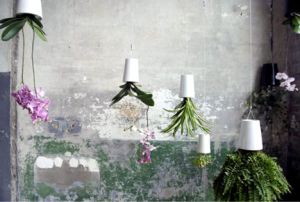
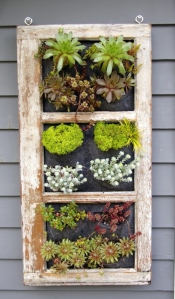
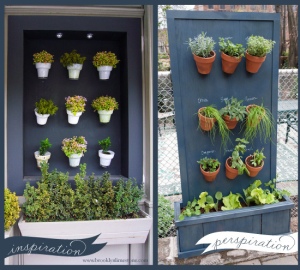
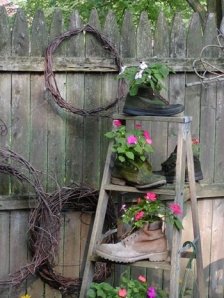
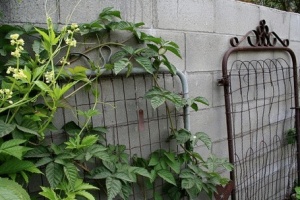
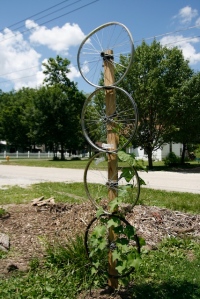
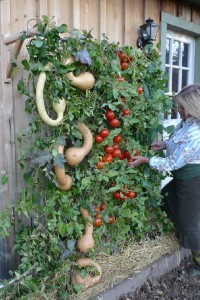
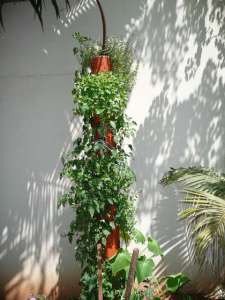
Many thanks for this great blog! Just wondering, is the first photo upside-down or are those special anti-gravity plants? :-))
Antigravity. Cool right? Thanks for stopping by.